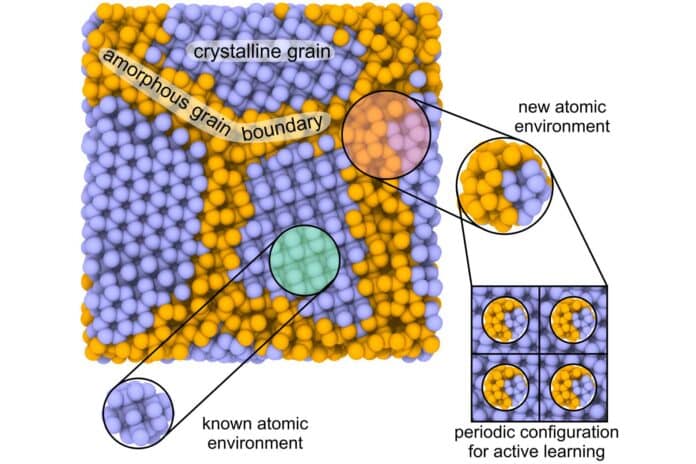The limited precision of empirical potentials and the large computer resources needed for ab initio approaches make it difficult to determine non-crystalline solids’ elastic and mechanical properties.
A Skoltech research team has created a brand-new machine-learning technique for examining the characteristics of composites, multiphase systems, and polycrystals. This method works with materials that have fewer than a few hundred atoms and achieves great accuracy that is practically similar to quantum-mechanical methods. The novel approach uses active learning strategies that concentrate on nearby atomic surroundings.
Faridun Jalolov, the study’s leading author and a Skoltech Ph.D. student in the Materials Science and Engineering program, said, “Many industrial materials are synthesized as polycrystals or multiphase systems. They contain both a single crystal and amorphous components between single crystal grains. The large number of atoms makes it hard to calculate the properties of these systems using modern quantum-mechanical methods.”
“Density functional theory can only be applied to materials with a few hundred atoms. To address the problem, we use a machine-learning approach based on Moment Tensor Potentials (MTP). These potentials have been also developed at Skoltech under the guidance of Professor Alexander Shapeev.”
According to scientists, the potential of the novel method lies in its capacity to apply active learning to local atomic contexts compared to prior systems. The Machine Learning Potential (MTP) detects calculation errors or inaccuracies in massive structures with hundreds of thousands of atoms, identifying the offending atoms. This could happen due to the small training dataset, which might only include some scenarios for a system.
This method separates the local environment of the detected atom and uses quantum mechanics to calculate its energy. For further learning, this data is then reintegrated into the training set. As this adaptive learning process progresses, calculations continue until they come across a different configuration that needs to be included in the training phase. This method is more applicable and precise than other machine-learning potentials because it can adapt to small local parts of large structures while other potentials cannot.
Faridun Jalolov said, “As an example, we studied the mechanical properties of diamond polycrystals, which are the hardest naturally occurring materials and often used in industry — for example, when manufacturing drilling equipment for oil wells. The results show that the mechanical properties of these polycrystalline diamonds depend on the grain size — the bigger the grain, the more similar the properties are to those of a single crystal diamond.”
Scientists noted, “This approach will allow studying the mechanical properties of nonsingle crystalline materials that are typically synthesized and used in experiments, as well as conducting comprehensive studies of polycrystalline and composite materials and obtaining data as close to experimental results as possible.”
Alexander Kvashnin, the head of the research and a professor at the Energy Transition Center, said, “In actual use, materials that are not perfect crystals are frequently employed due to their inability for perfect crystals to fully meet the requirements of a specific piece of equipment. A good example of this is tungsten carbide and cobalt.”
“By adding cobalt to tungsten carbide, the material becomes more crack-resistant, making it so valuable in applications. The new method will allow us to investigate the causes and ways of altering the mechanical properties of these multiphase systems on an atomic level.”
Journal Reference:
- Faridun N. Jalolov, Evgeny V. Podryabinkin, Artem R. Oganov, Alexander V. Shapeev, Alexander G. Kvashnin. Mechanical Properties of Single and Polycrystalline Solids from Machine Learning. Advanced Theory and Simulation journal. DOI: 10.1002/adts.202301171
